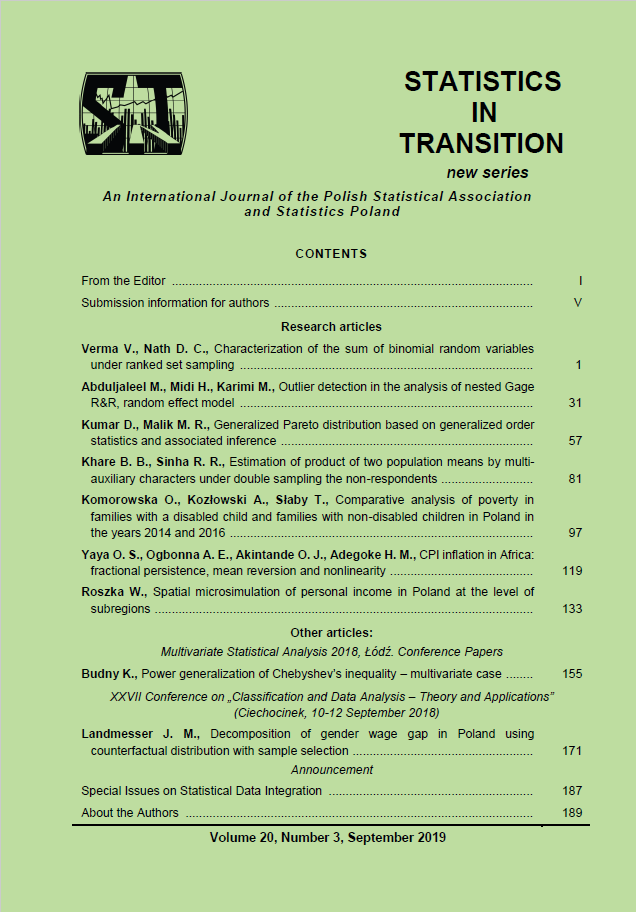ARTICLE
ABSTRACT
In the paper, we compare income distributions in Poland taking into account gender differences. The gender pay gap can only be partially explained by differences in men’s and women’s characteristics. The unexplained part of the gap is usually attributed to the wage discrimination. The objective of this study is to extend the Oaxaca-Blinder decomposition procedure to different quantile points along the income distribution. We use the RIF-regression method to describe differences between the incomes of men and women along the two distributions and to evaluate the strength of the influence of personal characteristics on the various parts of the income distributions. As the sample selection is a serious issue for the study, therefore our decomposition approach will be adjusted for sample selection problems. The results suggest not only differences in the income gap along the income distribution (in particular sticky floor and glass ceiling), but also differences in the contribution of selection effects to the pay gap at different quantiles. The analysis is based on data from the EU-SILC data for Poland in 2014.
KEYWORDS
gender wage gap, sample selection, decomposition of income inequalities
REFERENCES
ALBRECHT, J., VAN VUUREN, A., VROMAN, S., (2009). Counterfactual distributions with sample selection adjustments: Econometric theory and an application to the Netherlands. Labour Economics, 16 (4), pp. 383–96.
BLAU, F.D., KAHN, L.M., (2016). The Gender Wage Gap: Extent, Trends, and Explanations, Tech. rep. Cambridge: National Bureau of Economic Research.
BLINDER, A., (1973). Wage Discrimination: Reduced Form and Structural Estimates. Journal of Human Resources, 8, pp. 436–55.
BUCHINSKY, M., (1998). The dynamics of changes in the female wage distribution in the USA: a quantile regression approach. Journal of Applied Econometrics, 13 (1), pp. 1–30.
CENTRAL STATISTICAL OFFICE, (2016). Kobiety i mężczyźni na rynku pracy. Warsaw: Central Statistical Office.
DINARDO, J., FORTIN, N. M., LEMIEUX, T., (1996). Labor Market Institutions and the Distribution of Wages, 1973-1992: A Semiparametric Approach. Econometrica, 64, pp. 1001–44.
DONALD, S. G., GREEN, D. A., PAARSCH, H. J., (2000). Differences in Wage Distributions between Canada and the United States: An Application of a Flexible Estimator of Distribution Functions in the Presence of Covariates. Review of Economic Studies, 67, pp. 609–33.
FIRPO, S., FORTIN, N. M., LEMIEUX, T., (2009). Unconditional Quantile Regressions. Econometrica, 77 (3), pp. 953–73.
FORTIN, N., LEMIEUX, T., FIRPO, S., (2010). Decomposition methods in economics. NBER Working Paper, 16045.
GORAUS, K., TYROWICZ, J., (2014). Gender Wage Gap in Poland – Can It Be Explained by Differences in Observable Characteristics? University of Warsaw, Faculty of Economic Sciences, Working Papers, 11/2014 (128).
GORAUS, K., TYROWICZ, J., VAN DER VELDE, L., (2017). Which Gender Wage Gap Estimates to Trust? A Comparative Analysis. Review of Income and Wealth, 63 (1), pp. 118–46.
HECKMAN, J., (1976). The Common Structure of Statistical Models of Truncation. Annals of Economic and Social Measurement, 5(4), pp. 475-92.
HECKMAN, J., (1979). Sample Selection Bias as a Specification Error. Econometrica, 47(1), pp. 153–62.
JUHN, CH., MURPHY, K. M., PIERCE, B., (1993). Wage Inequality and the Rise in Returns to Skill. Journal of Political Economy, 101, pp. 410–42.
LANDMESSER, J. M., KARPIO, K., ŁUKASIEWICZ, P., (2015). Decomposition of Differences Between Personal Incomes Distributions in Poland. Quantitative Methods in Economics, XVI (2), pp. 43–52.
LANDMESSER, J., (2016). Decomposition of Differences in Income Distributions Using Quantile Regression. Statistics in Transition - new series, 17 (2), pp. 331-48.
MACHADO, J. F., MATA, J., (2005). Counterfactual Decomposition of Changes in Wage Distributions Using Quantile Regression. Journal of Applied Econometrics, 20, pp. 445–65.
MAGDA, I., TYROWICZ, J., VAN DER VELDE, L., (2015). Nierówności płacowe kobiet i mężczyzn. Pomiar, trendy, wyjaśnienia. Warszawa: Instytut Badań Systemowych.
OAXACA, R., (1973). Male-Female Wage Differentials in Urban Labor Markets. International Economic Review, 14, pp. 693-709.
ROKICKA, M., RUZIK, A., (2010). The Gender Pay Gap in Informal Employment in Poland. CASE Network Studies and Analyses, 406.
SŁOCZYŃSKI, T., (2012). Wokół międzynarodowego zróżnicowania międzypłciowej luki płacowej. International Journal of Management and Economics, 34, pp. 169–85.
ŚLIWICKI, D., RYCZKOWSKI, M., (2014). Gender Pay Gap in the micro level – case of Poland. Quantitative Methods in Economics, XV(1), pp. 159–73.
TÖPFER, M., (2017). Detailed RIF Decomposition with Selection - The Gender Pay Gap in Italy. Hohenheim Discussion Papers in Business, Economics and Social Sciences, 26-2017.
WEICHSELBAUMER, D., WINTER-EBMER, R., (2005). A meta-analysis on the international gender wage gap. Journal of Economic Surveys, 19 (3), pp. 479–511.
WORLD ECONOMIC FORUM, (2018). Global Gender Gap Report. http://reports.weforum.org/global-gender-gap-report-2018/.
